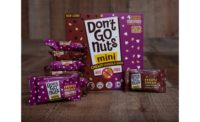Ask most Salted Nut Roll consumers and chances are they’re not purchasing a nougat, caramel and peanut bar as the nutritional equivalent of salad. Rather, they’re buying it for the taste, and because at $1.25, it’s still a good value.
Even Snickers, the ultimate “guy energy” bar continues to hold onto its claim of being the most popular candy bar of all time by delivering energy through that tried-and-true taste combination of peanuts, nougat and caramel.
Moreover, it’s still really affordable. With the most recent recession having affected every consumer’s pocketbook, many have had to adjust their purchasing and snacking habits.
Luckily for confectioners, the vagaries of the commodity markets as well as in unexpected hand of fate – as seen in the peanut recall precipitated by the Peanut Corporation of America’s salmonella outbreak – have made nuts truly affordable.
According to the National Confectioners Association (NCA)’s confectionery commodities’ report, the peanut crop is estimated at 3.63 billion pounds. Even though total supplies will be down only 7% from a year earlier, ending stocks are projected at a comfortable 1.6 billion pounds. Peanut prices are at about 45 cents for medium runners and are likely to remain at that level until next spring.
The NCA report also notes that bountiful almond and hazelnut harvests have also positioned those traditional confectioner inclusions at positive price points.For example, the U.S. almond crop in 2008/2009 reached 1.615 billion pounds. Current projections for the 2009/2010 year suggest 1.350 billion pounds, a result of lower commodity prices and some weather issues.
While the almond crop is not as big as the record 2008 crop, it is still expected to be the second or third biggest, about the same as in 2007/08 harvest. Walnut production is down 5% from last year’s record. Hazelnut production is up 19%. Prices for all of these should be reasonable, the NCA projects.
Consequently, confectioners should take advantage of such pricing opportunities by expanding their use of nut inclusions, providing consumers with enhanced value as well as variety.
It’s also important to note that nut inclusions - in broadening variety - can also add élan to new product development.
Consider the following almond treats gleaned from Mintel’s Global New Products Database: A seasonal Dia de los Muertos chocolate refined with almond and sea salt; dark chocolate almond butter cups; an artisan chocolate praline bar flavored with anise almond pepper; a Swiss milk chocolate with raisins, honey and almond nougat; Belgian chocolates with honey almond nougat and Canadian maple syrup; a dairy-free vegan product with coconut, almond and rice-milk chocolate coating; a bar with vegan marshmallows paired with roasted almonds and organic Belgian chocolate; and chocolate pralines with chili and almond.
Adding élan and value into chocolate bodes well as the premium chocolate category, particularly the mainstream premium chocolate segment, are projected to outpace the regular chocolate sales.
According to the Hazelnut Council, 58% of chocolate lovers still favor nut varieties, but 68% of today’s chocolate consumers are eager to try new flavors. Moreover, hazelnuts remain a new, exotic flavor to many consumers.
In addition to delivering value, confectioners can also take advantage of nuts’ overall healthy status. Recent studies extol the health benefits of peanuts, almonds, hazelnuts cashews, pecans and walnuts (See Candy Industry, January 2009 issue, pgs. 46-48). This hasn’t escaped consumers, who are increasingly aware of natural and functional ingredients.
For 2010, it’s a no-brainer; confectioners should simply go nuts.




